It's the last month of a busy year. Most of us have stashed away gloves and tools for the season, and some can kick off their boots by a toasty fire to warm their tired limbs. While our gardens sleep under a blanket of mulch and light snow and don't need attention, there are still plenty of things to think about and do.
For starters, look at the landscape, noticing its fundamental outlines and shapes. Tall or short deciduous trees, shrubs and evergreens comprise vertical walls, crucial focal points in the winter garden. With the leaves off deciduous woody plants, the architecture becomes apparent, and masses of shrubs or specimen trees take on new character — especially if they've got interesting bark, like the multistemmed redtwig or
yellow dogwood (
Cornus spp), or the
Japanese coral bark maple (
Acer palmatum 'Sango-kaku', zones 5 to 8), an outstanding cultivar with unusual coloration.
With everything looking bleak and empty, evergreens become the dominant landscape feature, so take stock — do you have a good mix of evergreens in your beds and borders?
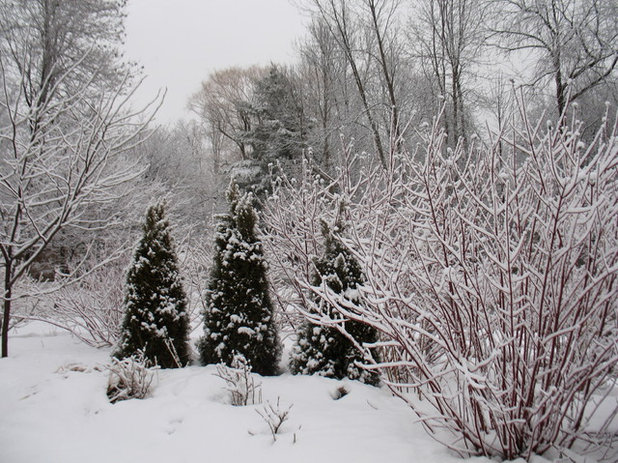
Paintbox Garden
Enjoy winter evergreens. Vertical evergreens, like the columnar
white cedar 'Emerald' (
Thuja occidentalis 'Emerald', zones 3 to 7), are great for mixed borders, as they punctuate space and take up little room. Planted in groups, they draw the eye and provide a good background to grasses and stonecrops.
Keep in mind that deer like to eat cedar and can easily defoliate plants. If you're in deer country, loosely wrap burlap as high as you can around the tree to protect it. It's ugly, yes — but it's better than having to replace your cedars, which is costly.
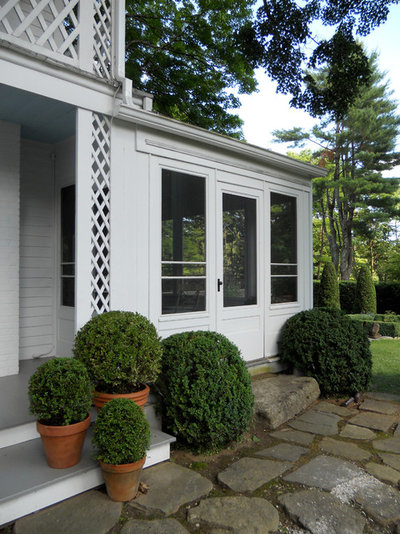
Paintbox Garden
Nothing beats boxwood for classic good looks in containers at this time of year, especially by doorways, where it can be dressed up with tiny white lights or left au naturel. For best effect, mix things up with different-size containers and plants, and make sure they're watered on a regular basis throughout the season. If you're using ceramic pots, it's best to keep them on a covered porch so freeze-thaw cycles don't damage the containers.
Boxwood (
Buxus spp) is also lovely in the winter garden when planted in groups of varying sizes with the creeping ground cover
bearberry (
Arctostaphylos uva-ursi, zones 2 to 6), which Native Americans call kinnikinnick. It's a dependable evergreen that likes acidic soils and full sun.
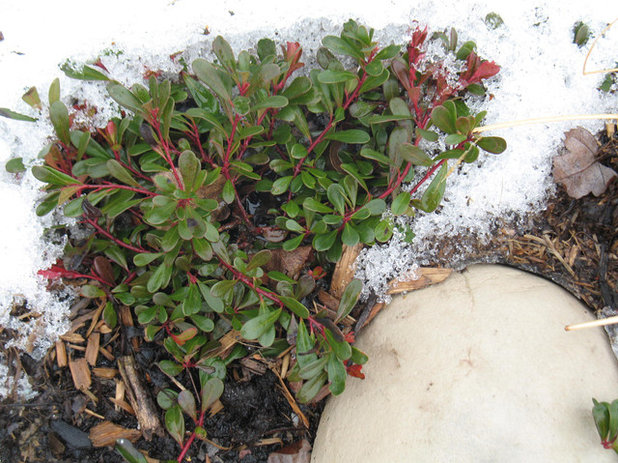
Paintbox Garden
Bearberry is a good choice for cold-climate areas where winters are harsh, and it looks especially good planted around the base of
white birch (
Betula spp).
Its distinct red stems contrast brightly with its glossy, rounded leaves, which turn bronze in dormancy. Good cultivars of this underused perennial include
'Massachusetts' and
'Emerald Carpet'.
Cut small bundles and tie them together with ribbon or twine to decorate place settings, or add them to fresh arrangements for the holiday table.
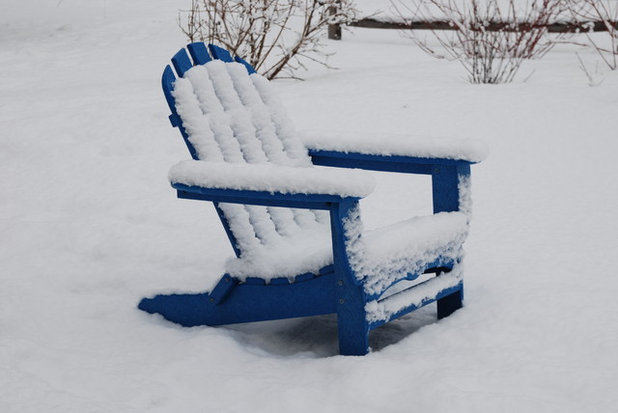
Paintbox Garden
Take stock of outdoor seating. Most patio furniture gets winterized under protective covers or moved into the garage, but the Adirondack-style seat shown here is made of tough postconsumer plastic from recycled milk jugs and can stand up to winter's worst weather. Because the material is a composite, the color won't fade and the chair resists cracking and splitting, unlike its wooden counterparts.
Furniture that stays in place is a nice option, and on mild days it's great to be able to sit outside and soak up the sun. Doesn't that sound better than dragging a lawn chair out of a storage shed?
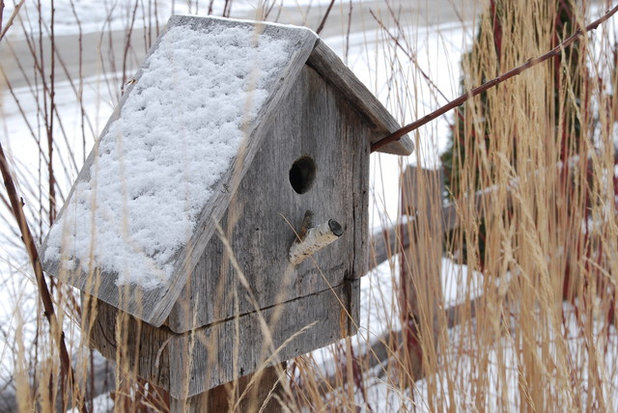
Paintbox Garden
Keep an eye out for winter wildlife. This birdhouse makes a great focal point from my kitchen window, and it's functional too. As juncos, cardinals and grosbeaks forage for crabapples and winterberries on my property, they often perch on its roof or land on the split-rail fence nearby.
Feeders hung from branches or wrought iron poles set in strategic locations can provide many hours of viewing pleasure. Be sure to install your feeder poles before the ground freezes solid.
It's true that birds are the flowers of the winter garden, bringing color and joy!
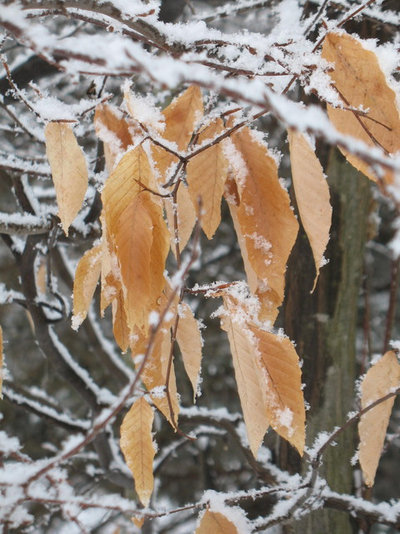
Paintbox Garden
Walk around your property and check trees for fallen limbs or broken branches. Winter storms can wreak havoc and cause widespread damage; get outside with a broom following wet, heavy snow and brush it off shrubs and small trees to prevent permanent damage.
Collect branches and add them to a brush pile on your property — somewhere out of view, where they can decompose and form a shelter for wildlife.
Light pruning can be done at any time now that plants are dormant. Look for healthy bud tips and snip off dead branches to add to the brush or burn pile.
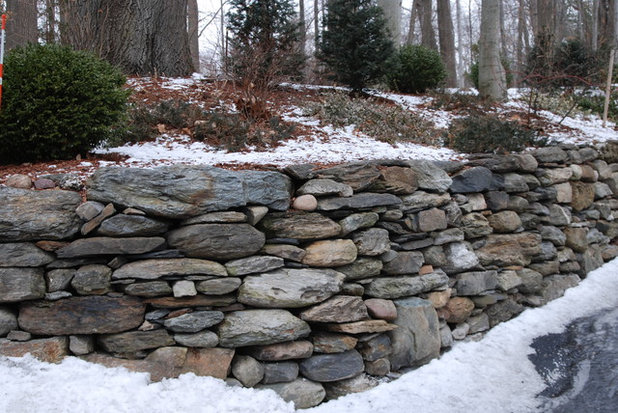
Paintbox Garden
Note areas that might need stonework. Start getting names of reputable masons or landscape contractors who service your community.
If you're a new property owner, note slopes and grade changes that might require retaining walls and be prepared to spend some hard-earned money on hardscaping next year. Be sure to check references and make sure your contractor is fully insured.
Smaller projects, like walkways, patios and seat walls, are good to think about in the landscape design process; the stripped-to-the-bones view of your property at this time of year can make you see where privacy is needed or where to route a stepping stone path through a side yard.

Paintbox Garden
Get outside with a camera and take photos of your garden. Back indoors, you can brew a pot of tea and review the images while you thaw.
Keeping photos organized in easy-to-access folders on your computer can help immensely as you plan your next move. You can arrange plants by specific areas of the garden, such as "Front Walk" or "Peony Bed," or group them by categories, such as foliage or flowers. It's great to have a visual record of your landscape, especially as you chronicle the growth and development of new areas. I'm amazed at the transformation of a long border I installed a couple years ago — I'd forgotten how little everything was!
See how to organize photos in a flash





